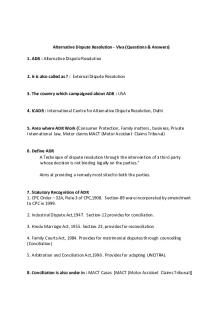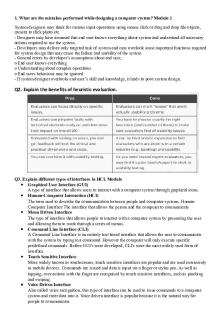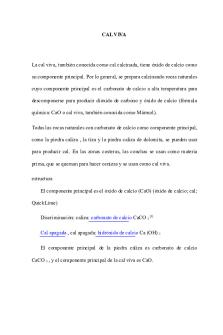Air Data Systems Viva Notes PDF

| Title | Air Data Systems Viva Notes |
|---|---|
| Author | Dakshesh Gusain |
| Course | Avionics |
| Institution | Amrita Vishwa Vidyapeetham |
| Pages | 9 |
| File Size | 651.5 KB |
| File Type | |
| Total Downloads | 92 |
| Total Views | 135 |
Summary
A summary of the viva notes covering all the topics related to air data systems in the avionics course....
Description
The air data quantities pressure altitude, vertical speed, calibrated airspeed, true airspeed, Mach number, etc., are derived from three basic measurements:
Total pressure: o a Pitot tube facing the moving airstream measures the impact pressure, QC, that is the pressure exerted to bring the moving airstream to rest relative to the Pitot tube plus the static pressure, PS, of the free airstream, i.e., PT = QC + PS .
Static pressure: o The static pressure of the free airstream, PS, is measured by an absolute pressure transducer connected to a suitable orifice located where the surface pressure is nearly the same as the pressure of the surrounding atmosphere.
Total temperature: o a temperature sensor installed in a probe in the airstream gives a measure of the free airstream temperature, TS , plus the kinetic rise in temperature due to the air being brought partly, or wholly, to rest relative to the temperature sensing probe
If we have PT and PS, we can:
calculate Pressure altitude HP: HP = PS calculate vertical speed VS = differentiate PS Cailbrated airspeed Vc = Qc (impact pressure)= (PT-PS) Mach number M = (true air speed)/(speed of sound) = (PT/PS)
the two basic quantities which are fundamental for the piloting of any aircraft are the pressure altitude (HP), and the calibrated airspeed (Vc)
Pressure altitude is the height of the aircraft above sea level Calibrated airspeed is the speed which, under standard sea level conditions, would give the same impact pressure as that measured on the aircraft Calibrated Airspeed: provides a direct measure of the impact pressure, by definition, and the impact pressure together with the angle of incidence determine the aerodynamically generated lift and drag forces and moments acting on the aircraft. ( ) Impact pressure
At low airspeeds (200Knots or 100m/s),
This relationship no longer holds as the speed increases and compressibility effects increase, and the impact pressure becomes a function of Mach number as well
Critical speeds which affect the aircraft’s behaviour, controllability or safety are specified in terms of calibrated airspeed as this is independent of the air density variation with altitude or temperature. o rotation speed for take off, the stalling speed and the not to exceed speed in a dive Indicated airspeed (IAS) = Vc, but also includes the pressure error in the pitot tube (and the indicator instruments in simple mechanical airspeed indicator)
Pressure altitude – Accurate measurement of the aircraft’s altitude is essential for the control of the flight path in the vertical plane. For instance, to maintain adequate clearance of mountains and hills, etc., under conditions of poor visibility, flying in cloud or at night.
True airspeed – This information is displayed to the pilot for navigation purposes Mach number – As the aircraft speed increases and approaches the speed of sound, or exceeds it in the case of a supersonic aircraft, there is a large increase in drag, the lift characteristics change and the pitching moment characteristics change due to compressibility effects. The controllability also depends on the mach number Vertical speed or rate of climb/descent – differentiating the static pressure. o important during a ground controlled approach (GCA) where the pilot will set up a given rate of descent (and speed) in the approach to the airfield. Angle of incidence- lift increases linearly with AOA upto a point, then the airflow breaks leading to sudden loss of lift (stall) AIR DATA FOR KEY SUB-SYSTEMS: Air Data for Key Sub-systems : The ATC authorities specify the flight levels which aircraft must maintain in ‘controlled airspace’ in terms of pressure altitude and these are set so that there is a minimum of 1,000 ft vertical separation between aircraft flying in the vicinity of each other. FCS or flight control system – requires the air data to make adjustment to “gains” of the FCS with airspeed & altitude to compensate for variation in aircraft control and response o (no idea what gains are….searched the net but only able to find “gain scheduling”, In control theory, gain scheduling is an approach to control of non-linear systems that uses a family of linear controllers, each of which provides satisfactory control for a different operating point of the system.
o
Autopilot system – A number of autopilot control modes require air data information, e.g., ‘height acquire/hold’, ‘Mach number acquire/hold’ and ‘airspeed acquire/hold’ (autothrottle system).
o
Flight management system
o
Engine control systems
IMPORTANCE OF AIR DATA SYSTEMS SUMMED UP: o info to pilot: altitude, speed,α...
o o o o o o
atc transponder (altitude) flight control systems ( variable ‘k’- mr root locus) autopilot ( eg- height hold) navigation engine control systems
ALTITUDE–STATIC PRESSURE RELATIONSHIP:
By making certain assumptions regarding a ‘standard’ atmosphere it is possible to express the altitude above sea level at any point in the Earth’s atmosphere as a single valued function of the atmospheric pressure at that point.
If H is the altitude and T is the temperature the some certain things happen: o o As H increases, T decreases linearly, up to the tropopause (T = T0 – LH) o T above tropopause remains constant till stratopause o After Stratopause, as H increases, T increases linearly.
Some important relations:
o
o
Variation of ground pressure: (all that QFE and QNH shit):
If the standard ground level pressure (1013.25 mb) is set then the altimeter will read pressure altitude (or barometric altitude).
If QFE system is used, the pressure at ground level (not necessarily sea level) is set and the altimeter reads height above ground at this point if the QFE for the airfield is set, the altimeter will read zero on touch down (assuming an accurate instrument system).
If the QNH system is used the pressure at mean sea level (often computed) for the region concerned is set and the altimeter reads height above sea level,
Basically, QFE will give altitude wrt the ground and QNH will give altitude wrt the sea level
For example, consider sea level = 0m, airport at altitude 1000m and Aircraft at altitude 5000m. Then QNH will read altitude of AC as 5000m and QFE will read altitude of AC as (5000-1000) = 4000m
We hear planes while landing reading out altitude (50..40…30..20..10..retard), they probably use QFE, hence at touchdown, QFE reads 0
SPEED OF SOUND:
The speed of sound reduces with increasing altitude as the temperature decreases until the tropopause height is reached. Thereafter the speed stays constant within the stratosphere height band as the temperature is constant.
the speed of sound depends only on the temperature of the air
ROCI: Rate of Change in pressure
nothing but the vertical speed indicator, gives rate at which you climb or descend. Calibrated leak gives time factor
AIR SPEED MEASUREMENT:
PRESSURE SPEED RELATIONS:
Total pressure PT, Static Pressure PS, True airspeed VT and local speed of sound A , these would lead to understanding Mach no. M and calibrated air speed VS
Mach number:
As Mach number increases pressure ratio Pt/Ps increases not linearly
CALIBRATED AND TRUE AIRSPEED:
Calibrated airspeed = Qc o
At low airspeed:
o
At subsonic:
o
At supersonic:
As the Vc value increases, Qc increases, non-linearly
True Airspeed:
True airspeed, Vt can then be obtained from the Mach number:
STATIC AIR TEMPERATURE Ts:
As already mentioned, the temperature sensed by a thermometer probe in the airstream is the free airstream temperature plus the kinetic rise in temperature due to the air being brought partly or wholly to rest relative to the sensing probe: Thus there is a difference between static temperature (Ts) and measured temperature (Tm)
TRUE AIR SPEED can also now be written as:
Height increases
IAS constant
CAS Constant
EAS Decrease
TAS Increase
REFER PAGE 400 OF BOOK FOR AIR DATA FORMULAE (PAGE 417 IN EDGE BROWSER)
Mach Increase
AIR DATA SENSORS AND COMPUTING:
The key air data sensors, as already mentioned, comprise two pressure sensors and a temperature sensor. Air data pressure sensors require an extremely high accuracy, Like most sensors, they not only sense the quantity being measured but they can also be affected by: o Temperature changes o Vibration o Shock o Acceleration o Humidity
The art of sensor design is to minimise and if possible eliminate these effects on the sensor.
The effect of a small error in static pressure measurement and the resulting altitude error:
∫
We substitute Ps (static pressure) depending on altitude and error pressure in (p) For example: 100Pa error at sea level, H =
Similarly, 100Pa error at FL 42650:
∫
()
This means that there is a difference of 38.43m in actual vs calculated height The need for accuracy in the static pressure measurement at the high altitudes used in cruise flight can be seen bearing in mind ATC height level separations of 1,000 ft. Total pressure sensor error:
TWO MAIN TYPES OF PRESSURE SENSORS:
Vibrating type Solid state
VIBRATING:
Frequency proportional to pressure The basic concept of this family of sensors is to sense the input pressure by the change it produces in the natural resonant frequency of a vibrating mechanical system.
The output of the sensor is thus a frequency which is directly related to the pressure being measured. This frequency can be easily measured digitally with very high resolution and accuracy without the need for precision analogue to digital conversion circuitry. This confers a significant advantage as it enables a very simple and very accurate interface to be achieved with a micro-processor for the subsequent air data computation.
SOLID STATE:
This type of pressure sensor consists essentially of a capsule with a relatively thin diaphragm which deflects under the input pressure The deflection of the diaphragm is linear with input pressure but is also very small and a number of techniques are used to measure this deflection The deflection of the solid state capsule under pressure is typically only 25 to 50 µm full scale The applied input pressure causes the resistance of the radial elements to decrease and the tangential elements to increase, if the pressure is increasing Unbalances the Wheatstone’s bridge
ANGLE OF ATTACK AND STALL
Knowledge of the angle of incidence can become particularly important at the extremes of the flight envelope when high values of incidence are reached and the limiting conditions approached. Many aircraft have incidence sensors installed so that the pilot can ensure the aircraft does not exceed the maximum permissible angle of incidence. A typical incidence sensor comprises a small pivoted vane suitably located on the aircraft fuselage near the nose of the aircraft. The vane is supported in low friction bearings so that it can align itself with the incident airflow under the action of the aerodynamic forces acting on it, like a weather vane. The angle of the vane relative to the fuselage and hence the angle of incidence is measured....
Similar Free PDFs

Air Data Systems Viva Notes
- 9 Pages

Data Structure Viva - CS NOTES
- 14 Pages

Data Structure Viva Questions
- 3 Pages

VIVA Notes
- 30 Pages

ADR Viva QS - ADR VIVA
- 7 Pages

VIVA VOCE - Lecture notes abcd
- 1 Pages

HMI VIVA - HMI Viva Peparation
- 9 Pages

CAL VIVA - Resumen sobre cal viva
- 14 Pages

AIR 452 Final Notes
- 24 Pages

Air Bnb Case notes
- 3 Pages
Popular Institutions
- Tinajero National High School - Annex
- Politeknik Caltex Riau
- Yokohama City University
- SGT University
- University of Al-Qadisiyah
- Divine Word College of Vigan
- Techniek College Rotterdam
- Universidade de Santiago
- Universiti Teknologi MARA Cawangan Johor Kampus Pasir Gudang
- Poltekkes Kemenkes Yogyakarta
- Baguio City National High School
- Colegio san marcos
- preparatoria uno
- Centro de Bachillerato Tecnológico Industrial y de Servicios No. 107
- Dalian Maritime University
- Quang Trung Secondary School
- Colegio Tecnológico en Informática
- Corporación Regional de Educación Superior
- Grupo CEDVA
- Dar Al Uloom University
- Centro de Estudios Preuniversitarios de la Universidad Nacional de Ingeniería
- 上智大学
- Aakash International School, Nuna Majara
- San Felipe Neri Catholic School
- Kang Chiao International School - New Taipei City
- Misamis Occidental National High School
- Institución Educativa Escuela Normal Juan Ladrilleros
- Kolehiyo ng Pantukan
- Batanes State College
- Instituto Continental
- Sekolah Menengah Kejuruan Kesehatan Kaltara (Tarakan)
- Colegio de La Inmaculada Concepcion - Cebu





